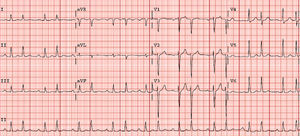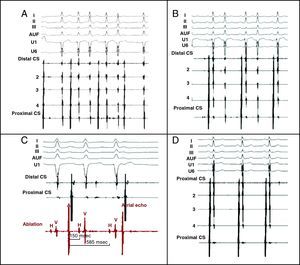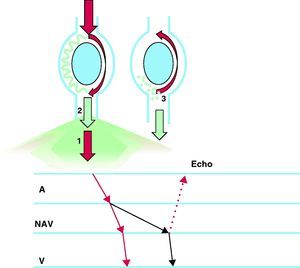Atrial fibrillation can be triggered by rapid atrial rhythms, including intranodal tachycardia. We present the recordings of a male patient with paroxysmal atrial fibrillation referred for pulmonary vein ablation following failure of various antiarrhythmic drug treatments (bisoprolol, flecainide, and amiodarone). The initial study showed two QRS complexes with a single p wave. A double nodal pathway was suspected and later confirmed, which led to a change in the therapeutic strategy. This phenomenon is an electrophysiological manifestation of the double nodal pathway, but it is an uncommon finding because detection requires a large difference in the conduction times between the two pathways..
The baseline electrocardiogram (ECG) findings (Figure 1) were interpreted as supraventricular bigeminism. However, the electrophysiologic study showed that it was actually a spontaneous repetitive double nodal response that triggered runs of tachycardia (Figure 2A) and atrial fibrillation. The atrial activation occurred through both nodal pathways simultaneously, but at differing conduction velocities (Figure 2B), sometimes with posterior retrograde conduction by the fast pathway, which perpetuated it (Figure 2, Figure 3). Following ablation of the slow nodal pathway, the double response and runs of tachycardia disappeared (Figure 2D) and a continuous, decreasing AV and VA conduction pattern was seen..
Figure 1.
Figure 2.
Figure 3.
During follow-up, the patient remained asymptomatic, with stable sinus rhythm and no antiarrhythmic treatment. No recurrence was documented on Holter ECG at 3, 6, or 12 months..
Corresponding author: mrodrig3@hotmail.com






